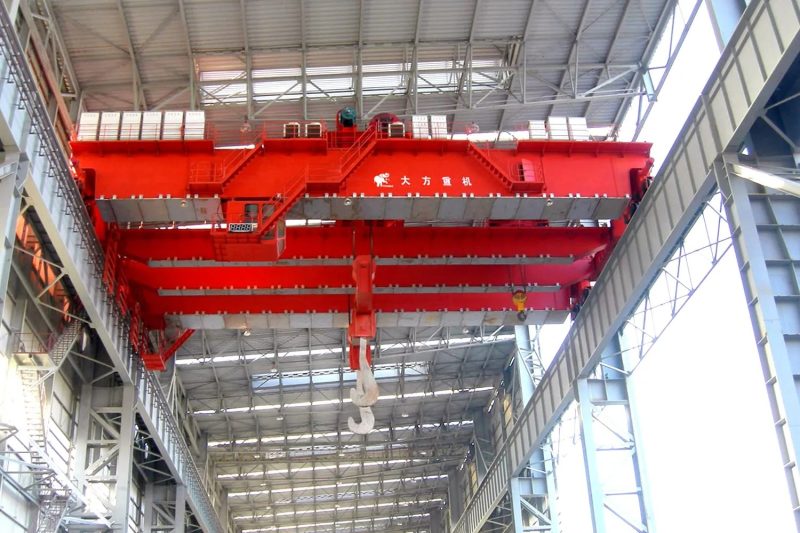In the dynamic world of modern industry, efficiency reigns supreme. Manufacturers and logistics operators are constantly seeking innovative ways to optimize their processes, enhance productivity, and minimize errors. Enter automated overhead crane systems – a game-changing technology that is reshaping material handling in manufacturing and logistics settings. In this article, we’ll delve into the world of automated bridge crane systems, uncovering the manifold benefits they bring to the table.
Automating the Lift: A New Era in Material Handling
Traditional material handling methods have long relied on manual labor and human intervention, leaving room for errors, delays, and inefficiencies. The introduction of automated overhead crane systems marks a paradigm shift. These advanced systems leverage cutting-edge technologies, such as sensors, cameras, and precision controls, to automate the entire material handling process. By seamlessly orchestrating tasks from lifting to transporting and placing, these cranes operate with a level of precision that minimizes the margin for error.
Benefits of Automated Overhead Crane Systems
1. Streamlining Workflow: Efficiency in Motion
The heart of any automated EOT crane system is its ability to streamline workflow. Picture a bustling manufacturing floor where raw materials need to be transported from one point to another. An automated crane, guided by programmed commands, can swiftly and accurately lift, move, and position these materials with minimal human intervention. This not only accelerates the overall production process but also frees up human resources for more value-added tasks. The result? A seamlessly flowing workflow that maximizes operational efficiency.
2. Reducing Human Error: Precision in Every Lift
Let’s face it – human error is an inevitable aspect of manual operations. In industries that deal with heavy loads and intricate processes, even a small mistake can have significant repercussions. Automated overhead crane systems address this challenge head-on. With sensors detecting load weight, position, and potential obstacles, the chances of accidents due to human error are drastically reduced. The precision offered by these systems ensures that materials are handled with the utmost care and accuracy.
3. Optimizing Safety: Minimizing Workplace Hazards
Safety is a cornerstone of any industrial operation. Automated overhead crane systems are designed with an array of safety features that minimize workplace hazards. Anti-collision sensors prevent cranes from colliding with each other or stationary objects, reducing the risk of accidents. Emergency stop buttons and fail-safe mechanisms add an extra layer of security. By minimizing the potential for accidents, these systems create a safer work environment for employees.
4. Data-Driven Insights: Enhancing Decision-Making
In the digital age, data is king. Automated bridge crane systems generate a wealth of data related to operations, performance, and maintenance. This data can be harnessed to gain valuable insights into process efficiency, identify bottlenecks, and predict maintenance needs. By making informed decisions based on real-time data, businesses can optimize their operations, reduce downtime, and drive continuous improvement.
5. Adapting to Dynamic Needs: Flexibility in Action
Industries are ever-evolving, with changing demands and requirements. Automated overhead crane systems offer a level of flexibility that enables them to adapt to dynamic needs. Programmable controls allow operators to easily modify the crane’s movements and parameters. This means that as your production processes evolve, your crane system can evolve with them, eliminating the need for major overhauls.
Three Crane Manufacturers Known For Their Expertise In Automatic Overhead Crane Systems:
1. Konecranes:
Konecranes is a global leader in lifting solutions, renowned for its innovation and advanced technology. They offer a wide range of automatic overhead crane systems designed to optimize material handling processes. Konecranes’ solutions are characterized by their precision controls, safety features, and seamless integration into various industries.
2. Dafang Crane:
Dafang Crane has established itself as a prominent name in the field of crane manufacturing, particularly in automatic overhead crane systems. Their systems are known for their precision engineering, customization options, and advanced safety features. Dafang Crane’s commitment to quality and innovative design sets them apart as a reliable choice for automated material handling solutions.
3. Demag Cranes:
Demag Cranes is recognized for its comprehensive range of crane solutions, including automatic overhead crane systems. Their systems are designed with a focus on efficiency, safety, and adaptability. Demag’s automated cranes are known for their seamless integration, user-friendly interfaces, and reliable performance across various industries.
These three crane manufacturers have earned their reputation through their dedication to innovation, quality, and customer satisfaction in the realm of automatic overhead crane systems.
Key Components of Automated Overhead Crane Systems
Automated overhead crane systems are a fusion of advanced technologies that work in harmony to revolutionize material handling processes. These systems go beyond traditional cranes, incorporating a range of key components that enable precision, efficiency, and seamless operation. Let’s explore these essential components that form the backbone of automated overhead crane systems:
1. Sensor Technology for Load Detection and Positioning:
At the core of any automated overhead crane system are sensors that enable accurate load detection and precise positioning. Load cells, encoders, and laser distance sensors work in tandem to provide real-time data about the weight and dimensions of the load being lifted. This information is crucial for the crane’s control system to calculate optimal lifting angles, speeds, and movements. By accurately detecting the load’s characteristics, the crane can ensure safe and efficient material handling.
2. Advanced Control Systems and Precision Movements:
Automated overhead crane systems are equipped with advanced control systems that dictate every movement of the crane. These control systems use data from the sensors to adjust the crane’s speed, acceleration, and deceleration according to the load’s weight and the environment. The result is a level of precision that minimizes load sway, enhances safety, and maximizes operational efficiency. Whether it’s delicate materials or heavy loads, the crane’s movements are orchestrated with meticulous accuracy.
3. Automation Software for Seamless Operation:
The brains behind the operation of an automated overhead crane system lie in its automation software. This software serves as the interface between the crane’s various components and the operator. It translates the data from sensors into actionable commands for the crane’s movements. Automation software enables operators to program specific tasks, set parameters, and monitor real-time data. This level of automation not only reduces human intervention but also ensures consistent and repeatable material handling processes.
4. Integration with Industry 4.0 Technologies:
In the era of Industry 4.0, connectivity and data exchange are paramount. Automated overhead crane systems are designed to seamlessly integrate with other Industry 4.0 technologies. This integration enables real-time data sharing between the crane and other systems, such as warehouse management systems or enterprise resource planning (ERP) software. The result is a synchronized ecosystem where information flows seamlessly, optimizing the entire production or logistics process.
The success of automated overhead crane systems hinges on the synergy of their key components. Sensor technology provides vital load information, while advanced control systems translate this data into precise movements. Automation software acts as the bridge between human operators and the crane’s automated functions. Lastly, integration with Industry 4.0 technologies elevates the crane’s capabilities by fostering connectivity and data exchange. Together, these components empower automated overhead crane systems to transform material handling, driving efficiency, safety, and productivity to new heights.
A New Horizon of Efficiency
In the realm of material handling, automated overhead crane systems are propelling industries toward a new horizon of efficiency and productivity. Through their ability to streamline workflow, reduce human error, enhance safety, provide data-driven insights, and adapt to changing needs, these systems are reshaping the landscape of manufacturing and logistics. As industries continue to embrace automation, the benefits of these advanced crane systems will undoubtedly play a pivotal role in driving operational excellence.










